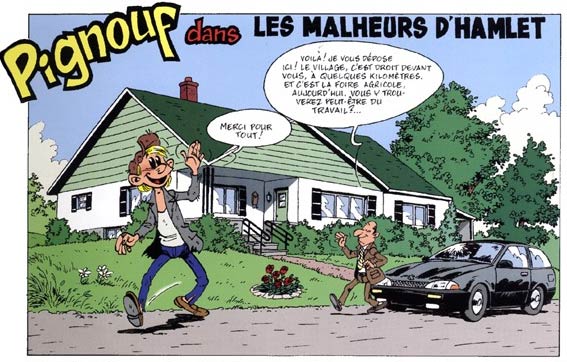Yves Rodier is a French-Canadian comic artist and animator, who gained notoriety as a Hergé fan and pastiche artist. He is well known for creating a bootleg version of the final unfinished 'Tintin' story 'Tintin and the Alpha Art' (1991). Rodier's best-known comic series are the humorous adventure series 'Simon Nian' (2005- ), scripted by François Corteggiani, and the wrestling comic 'El Spectro' (2011-2013), scripted by Frédéric Antoine.
Early life
Yves Rodier was born in 1967 in Farnhem in the Quebec region Montérégie. He grew up reading his brother's old copies of the comic magazines Tintin and Spirou. He also read Pif Gadget and especially enjoyed reading Hergé's 'Tintin' and René Goscinny and Albert Uderzo's 'Astérix'. Despite his passion for comics, Rodier studied music and later cinematographic techniques at the Cégep in St-Hyacinthe.
Sample from Yves Rodier's version of 'Tintin et L'Alph-Art' (1991).
Tintin et L'Alph Art
In 1986, Rodier eventually returned to comics, starting with a fan project. At the time, Hergé's final, unfinished 'Tintin' story, 'Tintin et l'Alph Art' ('Tintin and the Alpha Art'), had been released in book form, presented the way Hergé left the material behind, as a group of sketched out pages, the majority still nothing more than doodles and scribblings in lay-out format. While there was already a semblance of a plot, the story ended on a cliffhanger, with no indication where the plot might be heading. As early as 1988, a pseudonymous artist named Ramo Nash (named after a character from the story), released a bootleg version, which completed the story with his own imagination. Another artist who made his own version of 'Tintin et L'Alph-Art' was Régric.
Rodier also jumped on the bandwagon and drew his own version of 'Tintin et L'Alph Art'. In 1991, presented it to the Hergé Foundation, even in the presence of Hergé's former assistant Bob de Moor, to ask official permission to release the comic, if necessary with De Moor reworking it closer to Hergé's style. De Moor already had asked for this permission after Hergé's death and, much to his disappointment, had been rejected. Even a decade later, the situation remained unchanged. When De Moor died a year later, in 1992, the project seemed destined to remain unpublished. Nevertheless, Rodier did use the story as a calling card to present himself to publishers. In 1991, a bootleg version still hit the market and several translated versions still circulate on te Internet.
Other Tintin pastiches
Rodier's ability to reproduce the style of Hergé gained him a certain recognition in Europe, and got him in touch with European artists like Bob De Moor, François Walthéry, Jacques Martin and Greg. He gave interviews to Belgian newspapers and had regular appearances in Stéphane Steeman's fanzine Les Amis De Hergé. Rodier remained active as an unofficial 'Tintin' pastiche artist, drawing the characters on postcards, prints and other illustrations, all without knowledge or approval from the Hergé Foundation.
Several of Rodier's projects are finished versions of 'Tintin' stories that Hergé once considered as a vague idea, or sketched a few pages around, until to abandon them later again. In the first category, there's Rodier's 'A Day at the Airport' (1996), based on an interview in which Hergé stated that he contemplated a new 'Tintin' story set in an airport. Rodier only finished one page, which still leaked on the Internet. In the second category, there is 'Tintin et le Thermozéro', a story Hergé and Bob de Moor started in 1960, scripted by Greg. At the time, Hergé discontinued the story, since he never felt comfortable working with a scriptwriter. Rodier has also drawn and inked deleted scenes from 'Tintin' stories, like 'Tintin in Tibet'. In 1993, he also dug up a script for a 1957 drawing contest organized by comic magazine Spirou and adapted it into a 'Tintin' story. Rodier also used it for another drawing contest, but was disqualified since he used characters he didn't create himself.
Rodier has also made 'Tintin' stories completely based on his own scripts: 'The Witches Lake' (2003), 'Le Prisonnier du Dragon Rouge', 'Destination Hollywood' (in collaboration with Philippe Antoine, 2011) and 'Tintin à Hollywood' (2020).
'Pignouf et Hamlet'.
Pignouf et Hamlet
In 1995, Rodier was asked by editors Daniel and Richard Houde to join the team of Pignouf magazine, and was assigned to draw the title comic 'Pignouf et Hamlet' from scripts by Daniel Houde (who used the pen name David). The magazine only lasted for five issues, but the series was continued in the book 'La Bande Sauvage' at the publishing house Mille-Îles in 2000. A second book called 'La Grippe du Tigre' remained unfinished.
Animation career
In the early 2000s, Rodier moved to France, to work in the animation industry. He did lay-outs and poses for productions like 'L'Aventure de l'Écriture', 'Bob Morane', 'Papyrus' (based on Lucien de Gieter's comic strip) and 'Fantômette' (adapted into a comic strip by François Craenhals). He was a storyboard artist for 'Heavy Metal 2000', the series 'Les Aventures d'une Mouche' (based on the Lewis Trondheim comic), and the animated series with André Franquin's 'Marsupilami'.
Simon Nian
In 2005, Rodier returned to comics with the series about attorney at law 'Simon Nian', published by Éditions Glénat. Written by François Corteggiani, the comic shows clear influences from Maurice Tillieux. Tillieux' daughter, Régine Tillieux, also wrote the foreword to the first album. In total, three albums were published by Glénat.
El Spectro
Both Tillieux and Jean Graton were influences on Rodier's next project about a Mexican wrestler, 'El Spectro', written in cooperation with Frédéric Antoine. Two albums were published by Le Lombard, the first in 2011 and the second in 2013.
Recognition
In 1996, Rodier received the 'Espoir Québécois' award at the Québec Comic Festival. He was named "Most Promising Local Artist" for his work on 'Pignouf et Hamlet' and his Tintin parodies.







